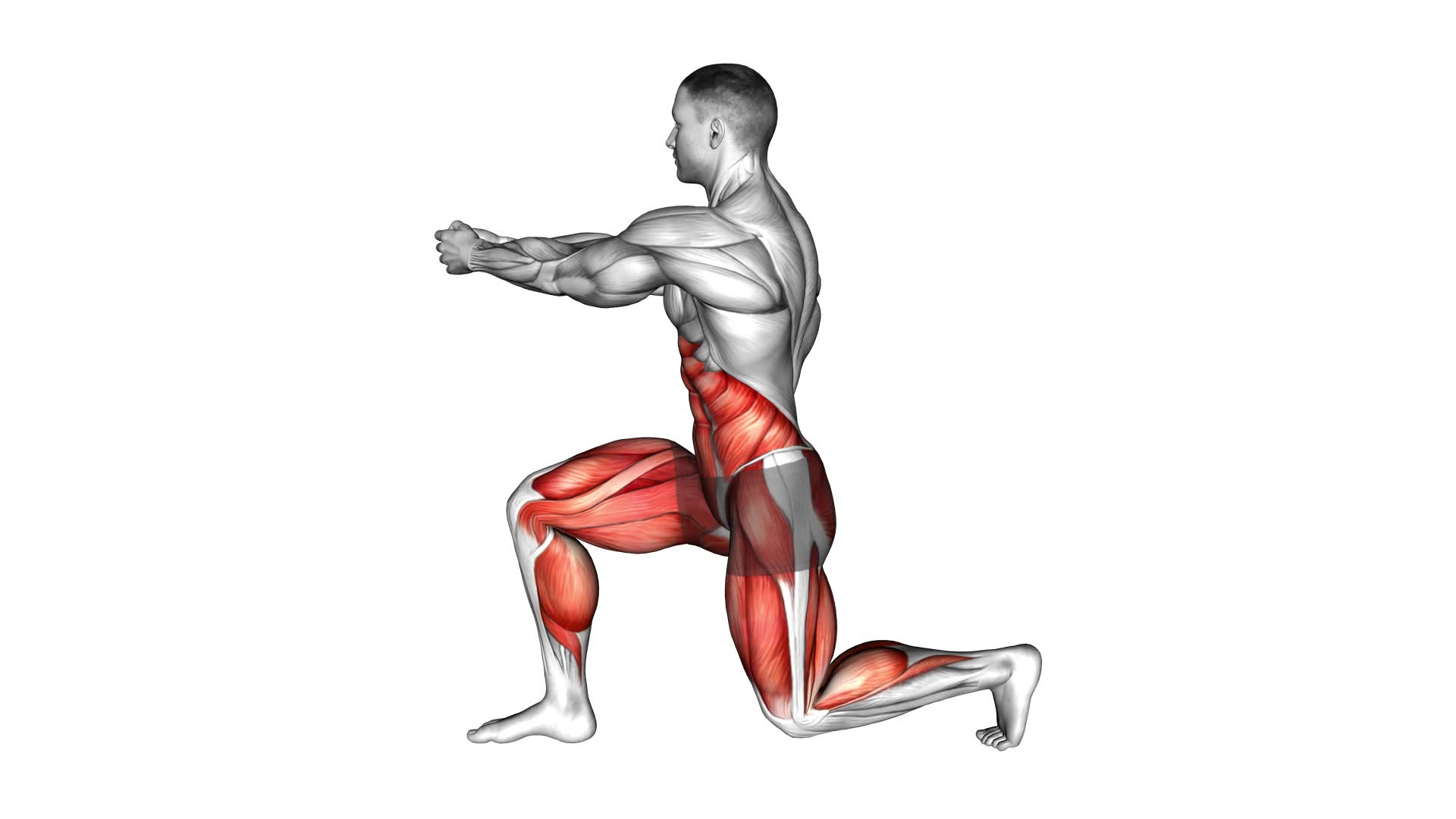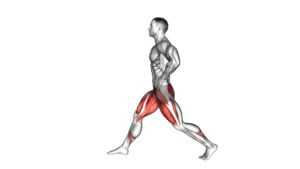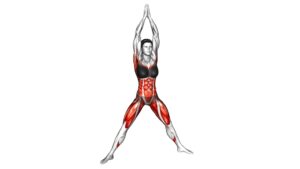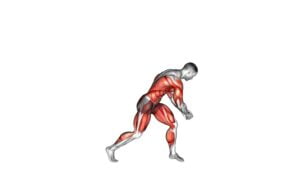Static Lunge Rotational Chop (male) – Video Exercise Guide & Tips

Incorporate the static lunge rotational chop into your workout routine for a challenging and effective exercise.
Watch This Exercise Video
This video exercise guide and tips will help you master the proper technique and avoid common mistakes.
With variations and progressions available, you can customize the static lunge rotational chop to your fitness level.
Get ready to strengthen your muscles and improve your overall fitness with this dynamic exercise.
Key Takeaways
- Improved core strength and stability
- Targets quadriceps, hamstrings, glutes, and calf muscles
- Engages rectus abdominis, obliques, and transverse abdominis
- Customizable for different fitness levels
Benefits of the Static Lunge Rotational Chop
You will experience improved core strength and stability from performing the Static Lunge Rotational Chop exercise. This exercise targets several key muscles in your body. The primary muscles targeted are the quadriceps, hamstrings, glutes, and calf muscles. These muscles work together to help you maintain balance and stability during the exercise.
Additionally, the rotational chop motion engages your core muscles, including the rectus abdominis, obliques, and transverse abdominis. Strengthening these muscles can enhance your overall core strength and stability, which is beneficial for various activities and sports.
To modify the Static Lunge Rotational Chop for different fitness levels, you can make a few adjustments. For beginners or those with limited mobility, you can start with a shorter lunge stance and decrease the range of motion during the rotational chop. This will allow you to focus on proper form and gradually increase the difficulty as you progress.
For more advanced individuals, you can increase the difficulty by adding weight or using a resistance band. This will intensify the workout and challenge your muscles even further.
Remember to always listen to your body and work within your limits. It's essential to maintain proper form and technique throughout the exercise to prevent injury and maximize the benefits.
Proper Technique for the Static Lunge Rotational Chop
To perform the Static Lunge Rotational Chop with proper technique, begin by positioning yourself in a lunge stance. Here's a step-by-step guide to help you execute the exercise correctly:
- Start by standing with your feet hip-width apart and take a step forward with one foot, ensuring that your knee is directly above your ankle.
- Lower your back knee towards the ground while keeping your upper body upright and your core engaged.
- Hold a medicine ball or weight with both hands in front of your chest, keeping your elbows slightly bent.
- As you lower into the lunge, rotate your torso towards the side of your front leg, bringing the weight diagonally across your body and towards the outside of your front foot.
By following these lunge technique tips, you'll effectively engage your core muscles and promote stability and strength throughout your body. The Static Lunge Rotational Chop is an excellent exercise for core strengthening, as it targets the abdominal muscles, obliques, and hip muscles.
Now that you know the proper technique for the Static Lunge Rotational Chop, let's move on to the next section and discuss common mistakes to avoid during this exercise.
Common Mistakes to Avoid During the Static Lunge Rotational Chop
When performing the Static Lunge Rotational Chop, it's important to be mindful of common mistakes and correct your form to maximize the effectiveness of the exercise. By avoiding these common mistakes, you can ensure that you're targeting the correct muscles and reducing the risk of injury.
One common mistake is using too much weight. While it may be tempting to go heavy, using excessive weight can compromise your form and put unnecessary stress on your joints. Start with a lighter weight and gradually increase as you become more comfortable with the movement.
Another mistake to avoid is rushing through the exercise. The Static Lunge Rotational Chop should be performed in a controlled and deliberate manner. Take your time and focus on the correct form and range of motion. This won't only make the exercise more effective, but also reduce the risk of injury.
Modifications and regressions can also be helpful if you're struggling with the exercise. For example, if you find it difficult to maintain balance, you can perform the exercise with your back foot resting on a bench or step. This will provide additional stability and support.
Variations and Progressions for the Static Lunge Rotational Chop
To further challenge yourself and continue progressing with the Static Lunge Rotational Chop, consider incorporating variations and progressions into your routine. These modifications and advanced lunge exercises won't only help you improve your balance and stability but also target different muscle groups for a more well-rounded workout.
Here are four variations to try:
- Weighted Static Lunge Rotational Chop: Hold a dumbbell or kettlebell in your hands as you perform the exercise. This added resistance will increase the difficulty and engage your muscles even more.
- Plyometric Static Lunge Rotational Chop: Add an explosive jump to the exercise by pushing off the ground with both feet and switching legs mid-air. This won't only challenge your lower body strength but also improve your power and agility.
- Reverse Static Lunge Rotational Chop: Instead of stepping forward into a lunge, step backward. This variation puts more emphasis on your glutes and hamstrings while still targeting your core and upper body.
- Single-leg Static Lunge Rotational Chop: Lift one foot off the ground and balance on the other leg as you perform the exercise. This variation requires greater stability and works your core and leg muscles in a different way.
Incorporating these static lunge modifications and advanced exercises into your routine will take your workout to the next level and help you achieve your fitness goals faster. Remember to start with lighter weights or modify the exercises as needed, and always maintain proper form to avoid injury.
Tips for Incorporating the Static Lunge Rotational Chop Into Your Workout Routine
To incorporate the Static Lunge Rotational Chop into your workout routine, focus on maintaining proper form and engaging your core throughout the exercise. This will ensure that you get the most out of the movement and minimize the risk of injury.
There are a few ways you can modify the static lunge rotational chop to suit your fitness level and goals.
Firstly, you can adjust the weight you use. If you're just starting out or want to focus on form, you can use a lighter weight or even just your body weight. As you become more comfortable and stronger, you can gradually increase the weight to challenge yourself further.
Another way to modify the exercise is by adjusting the position of your feet. For a more stable base, you can widen your stance or even perform the exercise in a split stance. This will engage different muscles and add variety to your workout routine.
In terms of equipment, all you really need for the static lunge rotational chop is a dumbbell or a kettlebell. If you don't have access to these, you can use a resistance band or even a medicine ball. The key is to use a weight that challenges you without compromising your form.
Incorporating the Static Lunge Rotational Chop into your workout routine can be a great way to improve your core strength and stability. By maintaining proper form, engaging your core, and making modifications as needed, you can maximize the benefits of this exercise.
Frequently Asked Questions
Can the Static Lunge Rotational Chop Be Modified for Beginners or Those With Limited Mobility?
Yes, the static lunge rotational chop can be modified for beginners or those with limited mobility. There are modified variations of this exercise that can accommodate different fitness levels and mobility restrictions. These modifications may include reducing the range of motion or using lighter weights.
The benefits of performing modified static lunge rotational chops include improved balance, stability, and core strength. It's also a great exercise for seniors as it helps maintain functional movement patterns and can be done at a lower intensity.
Is It Necessary to Use Weights or Resistance During the Static Lunge Rotational Chop?
Using weights or resistance during the static lunge rotational chop can provide additional benefits to your workout. It can increase the intensity and challenge your muscles even more. The added resistance can help to build strength and improve stability.
However, there are also pros and cons to using resistance bands. They can be more convenient and portable, but may not provide as much resistance as weights. Ultimately, the choice depends on your fitness goals and preferences.
How Often Should the Static Lunge Rotational Chop Be Performed in a Workout Routine?
To maximize the benefits of the static lunge rotational chop for core strength, it's important to perform it regularly in your workout routine. The exact frequency may vary depending on your fitness level and goals.
However, a general recommendation is to include this exercise 2-3 times per week. Make sure to execute it properly by maintaining proper form, engaging your core, and using controlled movements. This will help you achieve maximum effectiveness and avoid injury.
Can the Static Lunge Rotational Chop Help Improve Balance and Stability?
The Static Lunge Rotational Chop can definitely help improve your balance and stability. By incorporating this exercise into your workout routine, you aren't only targeting your core muscles but also enhancing your coordination.
This movement requires you to engage your core and maintain stability while performing the rotational chop. By consistently practicing this exercise, you can increase your core strength and improve your overall balance and stability.
Are There Any Specific Precautions or Contraindications for Performing the Static Lunge Rotational Chop?
When performing the static lunge rotational chop, it's important to be aware of any precautions or contraindications.
Precautions may include avoiding this exercise if you have any existing injuries or pain in the lower back, hips, or knees.
Contraindications may include certain medical conditions or limitations that prevent you from safely executing the movement.
Consulting with a qualified fitness professional or healthcare provider can help determine if this exercise is suitable for you.
Conclusion
Incorporating the static lunge rotational chop into your workout routine can provide numerous benefits, such as improving core strength, stability, and overall balance.
By following the proper technique and avoiding common mistakes, you can maximize the effectiveness of this exercise.
Additionally, there are variations and progressions available to challenge yourself as you become more proficient.
So, give this exercise a try and enjoy the benefits it brings to your fitness journey.

Author
Years ago, the spark of my life’s passion ignited in my mind the moment I stepped into the local gym for the first time. The inaugural bead of perspiration, the initial endeavor, the very first surge of endorphins, and a sense of pride that washed over me post-workout marked the beginning of my deep-seated interest in strength sports, fitness, and sports nutrition. This very curiosity blossomed rapidly into a profound fascination, propelling me to earn a Master’s degree in Physical Education from the Academy of Physical Education in Krakow, followed by a Sports Manager diploma from the Jagiellonian University. My journey of growth led me to gain more specialized qualifications, such as being a certified personal trainer with a focus on sports dietetics, a lifeguard, and an instructor for wellness and corrective gymnastics. Theoretical knowledge paired seamlessly with practical experience, reinforcing my belief that the transformation of individuals under my guidance was also a reflection of my personal growth. This belief holds true even today. Each day, I strive to push the boundaries and explore new realms. These realms gently elevate me to greater heights. The unique combination of passion for my field and the continuous quest for growth fuels my drive to break new ground.







